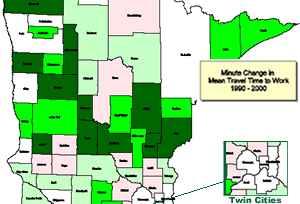 |
Recently released U.S.
Census Bureau data show that some of the longest commute times in Minnesota—ranging
from 30 to 32 minutes each—were for commuters in Isanti, Chisago, Kanabec,
Pine and Sherburne counties. Map provided by the Office of Investment
Management
|
Minnesota drivers statewide are spending more time commuting on average than
they were 10 and 20 years ago, according to U.S. Census Bureau data released
June 3.
The biggest rate of increase was not in the Twin Cities metropolitan area,
but in Greater Minnesota counties.
"This confirms what other studies have shown. Commute times are increasing
at a large rate in Minnesota," said Commissioner Elwyn Tinklenberg. "Of
even more concern is the fact that it’s no longer just a metro problem. Some
of the longest commute times in Minnesota—ranging from 30 to 32 minutes each—were
for commuters in Isanti, Chisago, Kanabec, Pine and Sherburne counties."
The average commute time in the seven-county metro area has grown from 20 minutes
in 1980 to 21 minutes in 1990 to 23 minutes in 2000.
Commute times increase
According to the census data, the rate of increase in commute times in Minnesota
has more than doubled since 1980. The average statewide commute time grew 14.7
percent (2.8 minutes) between 1990 and 2000, compared to a 6.7 percent (1.2
minutes) growth increase between 1980 and 1990. There are an estimated 1.4 million
commuters in the Twin Cities metropolitan area and 2.4 million commuters statewide.
More commuters driving alone
The data also showed that Minnesota continues to have a higher share of commuters
driving alone versus those using public transit. In the seven-county Twin Cities
metropolitan area, there was a 23 percent increase in the share of commuters
driving alone between 1980 and 2000.
However, the decline in transit use was smaller from 1990 to 2000 than from
1980 to 1990. Between 1996 and 2000, in fact, Metro Transit ridership in the
Twin Cities increased by 18.7 percent.
"Many of the counties with the greatest increase in commute times are
those that would have been served by the Northstar Commuter Rail project, which
the Legislature failed to fund this session," Tinklenberg said. "The
Northstar corridor, which would connect the St. Cloud/Rice area with downtown
Minneapolis along highways 10 and 47, is the fastest growing area in the state."
Annual urban mobility study
"We’re anxious to see what the Texas Transportation Institute’s annual
urban mobility study will say," said Tinklenberg. The TTI report, which
researches congestion rates in metropolitan areas nationwide, will be released
in mid-June.
"Last year, the Minneapolis/St. Paul area ranked second to Atlanta in
the rate of congestion growth and ranked as the nation’s 15th most congested
metropolitan area." In 1998, the Twin Cities area ranked 18th in congestion
and in 1990, it ranked 34th.
"We know that congestion in the metro area is getting worse and at a faster
pace than almost anywhere in the country," Tinklenberg said. "The
Legislature should take this seriously."
Census data, which the U.S. Census Bureau releases in stages, are a key planning
resource for Mn/DOT, regional development commissions and metropolitan planning
organizations. The Office of Investment Management is in the process of analyzing
the most recent data and has mapped it in several formats, including the minute
change in mean travel time to work from 1990-2000.
Click here to read the Mn/DOT
Newsline article (May 23, 2001) on early census results.
By Chris Joyce
|



